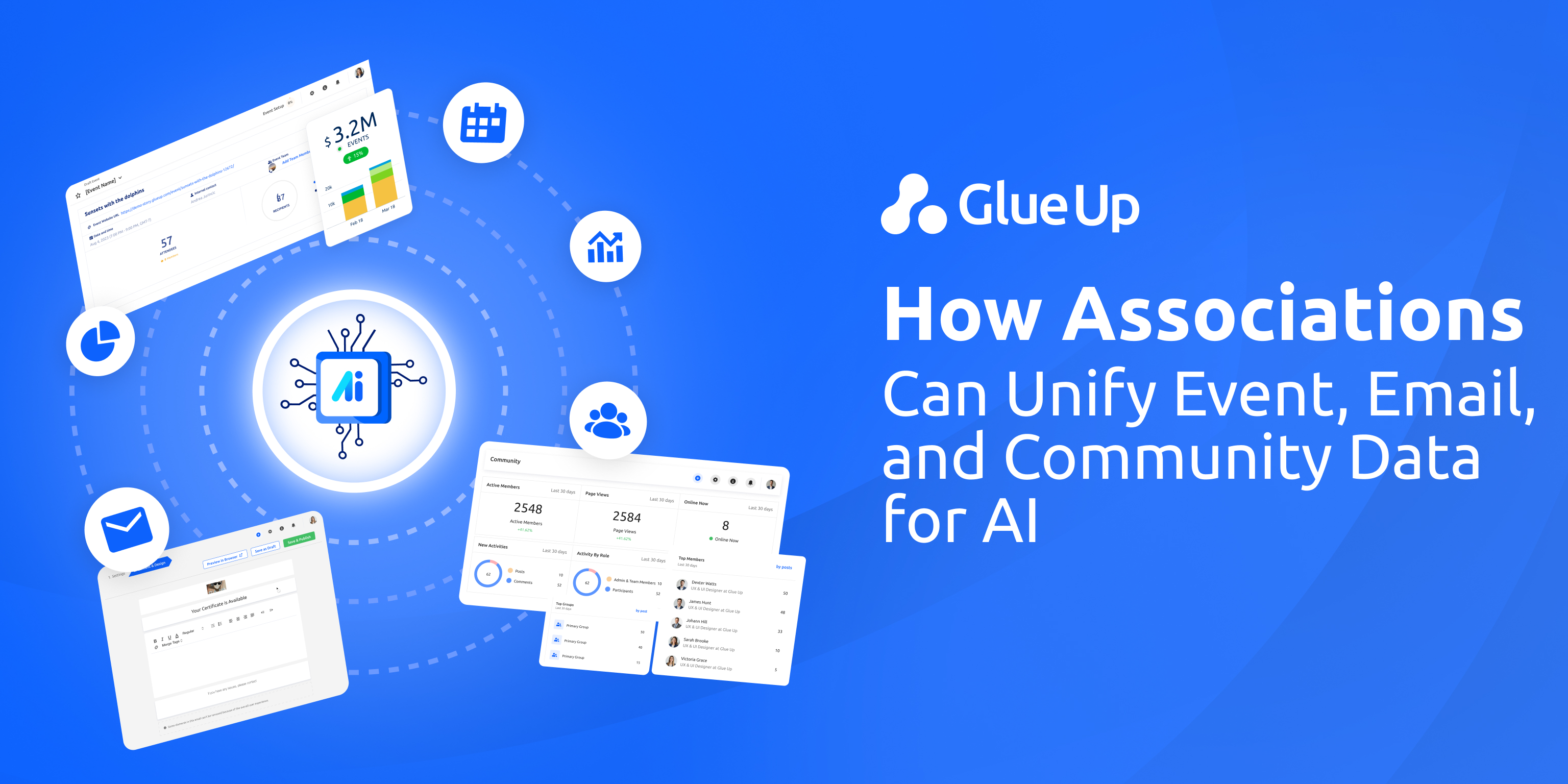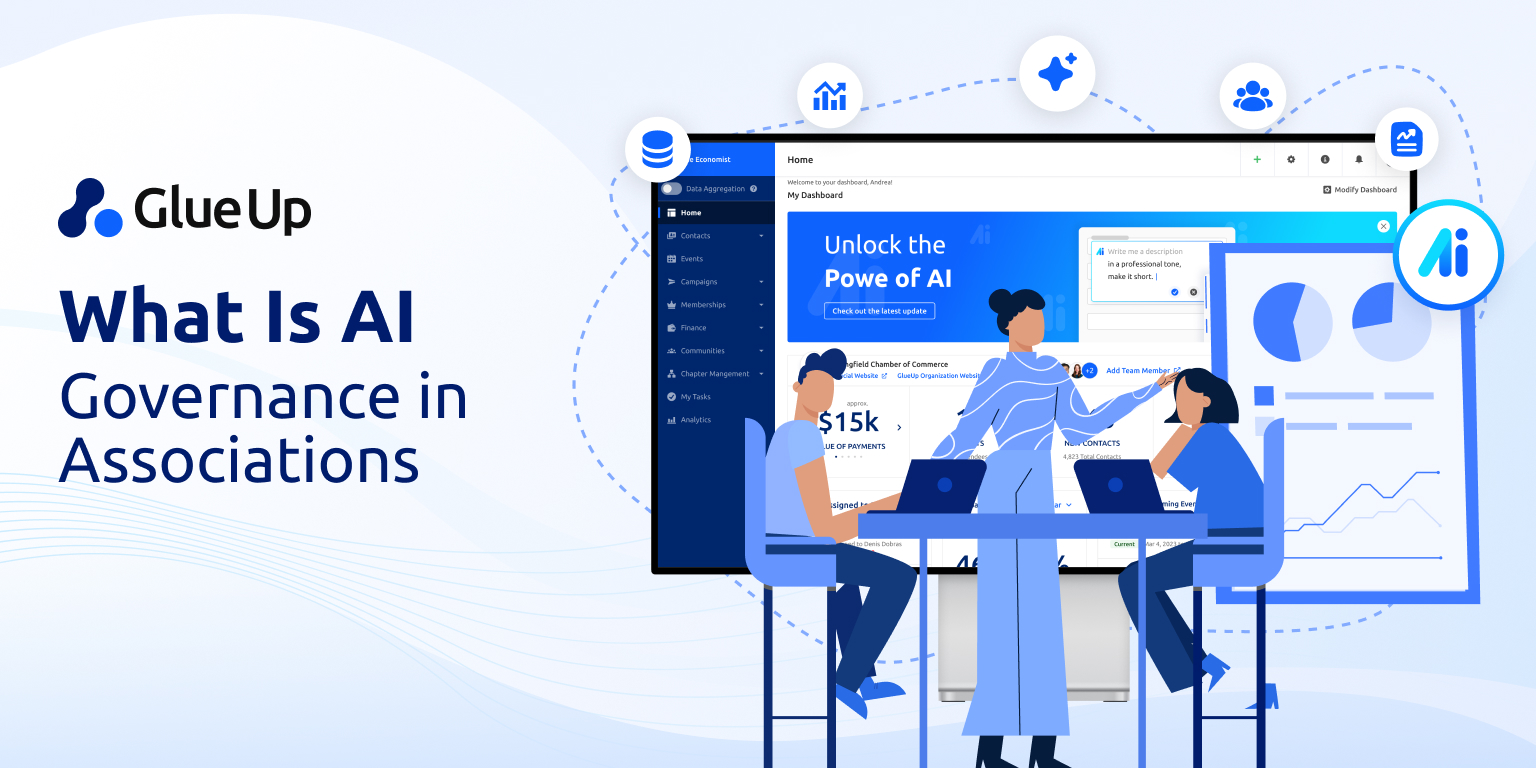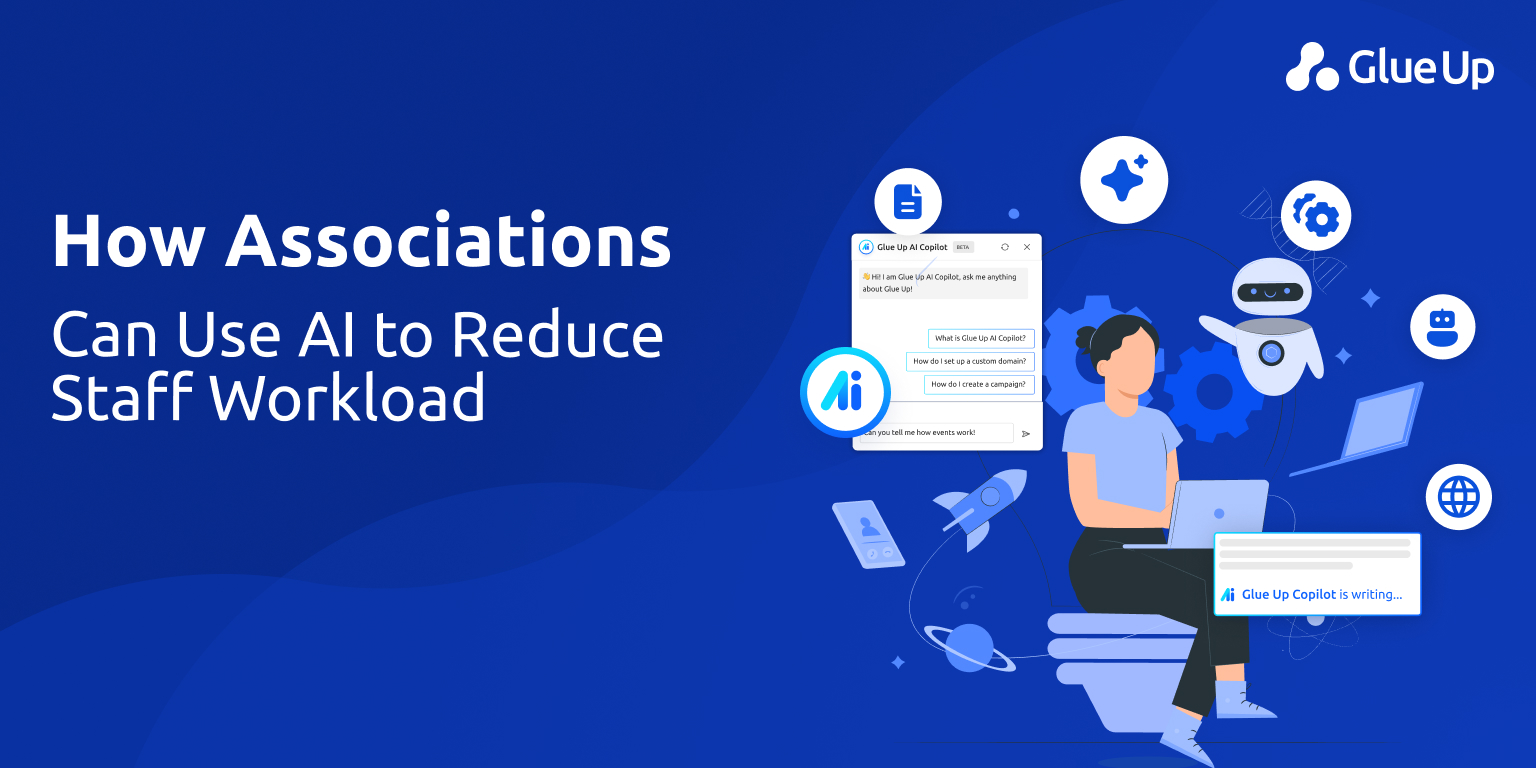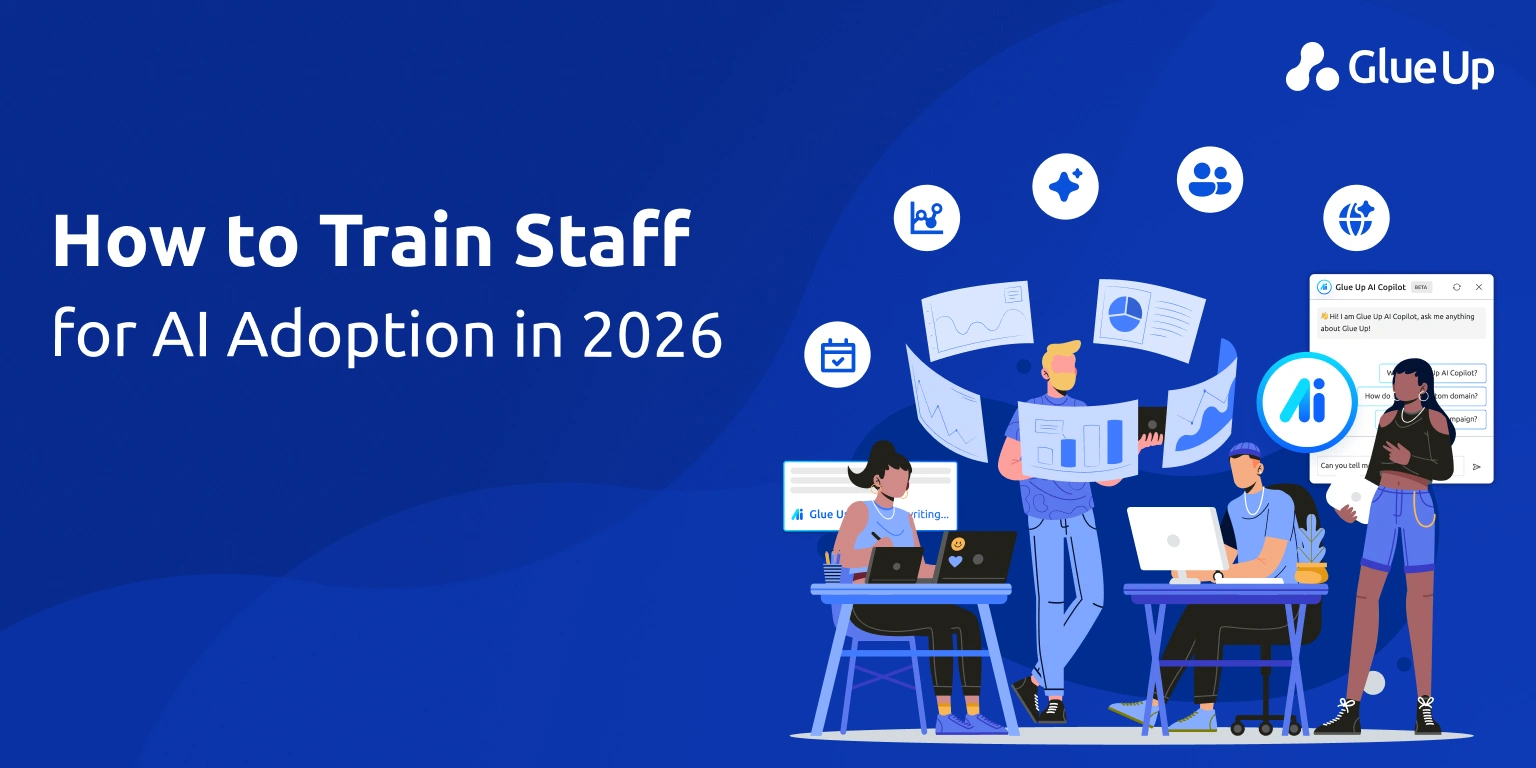
You’ve got the data. You’ve got the events, the emails and the community platform. Yet you’re still asking: “Why are engagement rates flat? Why is renewal stuck? Why do I feel like the pieces aren’t talking to each other?” That’s because the missing link is association workflow integration: a clear, connected architecture that brings event-, email- and community-data into one unified model, then uses it smartly with AI. Once you crack that, you stop chasing metrics and start capturing influence.
Key Takeaways
Associations already have rich data across events, emails, and communities, but it’s fragmented. True progress comes from association workflow integration, which connects these data streams into one system that AI can learn from. Without that connection, every engagement effort stays reactive and incomplete.
When event, email, and community data are unified, associations can deliver experiences members actually care about. Community-driven email digests, for example, show 44–56% open rates, far above traditional campaigns. The takeaway: integrated workflows drive real engagement.
AI can’t fix messy systems. Before adopting AI tools, associations must build a structured data model linking members, events, and interactions. A clear architecture, warehouse-first, reverse ETL activation, and governed workflows, turns AI from hype into daily utility for segmentation, recommendations, and forecasting.
Integration without trust is a liability. Strong data governance, SPF/DKIM/DMARC compliance, clear ownership, and audit trails ensure that AI insights stay ethical and reliable. Governance is the reason AI models remain fair, accurate, and ready for scaling.
Associations don’t need to overhaul everything at once. A simple pilot, linking one topic across community, email, and event, can show measurable results in 30 days. This practical “proof loop” demonstrates that association workflow integration isn’t a future concept; it’s a current growth strategy.
Quick Reads
The Problem: Signals Everywhere, Insight Nowhere
Imagine a scenario many associations know well. Your team runs a successful annual conference: dozens of sessions, hundreds of badges scanned, feedback gathered. At the same time, you’re sending monthly newsletters, community threads are active, chapters are hosting local meetups. But at the end of the quarter the board asks: “What did all that do for retention? For revenue? Which members should we nurture now?” Your answer: “We’re still analyzing spreadsheets.”
The moment you hear that; you realize event data lives in the registration platform; email data lives in the marketing platform; community data lives in a forum or portal that rarely integrates. As a result: duplicate member records, no single source of truth, manual stitching of engagement metrics. Every tool is powerful, but the combination is weak. This is the exact point where association workflow integration becomes so critical.
Where the Signals Live and Why Fragmentation Costs
Let’s map the domains:
Event data: registrations, attendance, session choices, badge scans, sponsor interactions.
Email data: opens, clicks, unsubscribes, segmentation codes, timing.
Community data: posts, replies, topic creation, resource library downloads, threads browsed.
Each domain offers a view of member behavior, but in isolation. If you know someone clicked on “digital transformation” in an email and attended a session on “AI in associations”, but you don’t tie that to what they posted in the community, you lose the insight of their ongoing interest.
If you know a member replies to numerous “chapter networking” threads but that never reflects in their event registration, you’re missing a cue to invite them to a local meet-up. The absence of linkages means you respond slowly; you personalize poorly, you waste opportunities.
Fragmentation costs budget and trust. When dashboards show conflicting numbers (one tool says, “100 members engaged”, another says “45 clicked”), you erode confidence in data and slow decision-making. The fix is association workflow integration that stitches those distinct signals into a coherent story.
Why Integration Matters, and the Proof It’s Working
You might wonder: “Is this just tech hype, or real results?” The evidence says real. For instance, the 2025 Association Community Benchmark Report found that community-digest emails achieved open rates of 44–56 %, far out-performing the typical association email average of ~36 %. That matters, because it shows when you tap peer-driven content (community) and connect it with your email channel, members respond.
Another insight: a survey found that 63 % of association meeting planners are using AI for event planning. That shows that the event domain is ripe, but it also signals that the hurdle is it’s tying in the data, so AI has something integrated to act on. According to a strategic consulting piece, associations are shifting from guesswork to strategy via AI, but only when the data model supports it.
So, the equation becomes: great data + isolated tool sets = incremental gains. Great data + association workflow integration + activation = exponential gains.
A Practical Data Model for Associations
Here’s a blueprint you can follow. Think of it as a simplified schema you map once, refine over time, and apply broadly.
Core Entities
Member (member_id, AMS_id, email, join_date, role, chapter)
Organization (org_id, industry, size, region)
Event (event_id, date, format, topic)
Session (session_id, event_id, topic, speaker)
Email_Message (email_id, subject, send_date, segment)
Community_Thread (thread_id, topic, start_date, original_poster_id)
Sponsor_Interaction (interaction_id, member_id, event_id, sponsor_id, scanned_badge)
Relationships
Member attends Session (joins via Event)
Member clicks Email_Message
Member posts/replies in Community_Thread
Member belongs to Organization
Sponsor_Interaction links Member and Event via Sponsor
By building and maintaining the above relationships you achieve several things: you tie email behavior to event attendance to community activity; you create a unified record of each member’s journey; you enable cross-domain segmentation (“members who clicked topic X in email, attended session Y, and replied in thread Z”). And this is the foundation for AI models that predict behavior, recommend content, or trigger engagement.
The term “association workflow integration” refers exactly to building workflows around that model: ingestion → clean model → activation.
The Modern Stack: How to Build the Integration
Here’s the architecture you should have in mind, think of it as three steps.
1. Ingest & Unify
Pull in data from your registration/event system, your email provider, your community platform, your AMS. Use a data warehouse (cloud-based or hybrid) to serve as your single source of truth. Avoid the temptation to rely solely on tool-to-tool integrations, they tend to create duplicates, mismatches and scale problems.
2. Model & Segment
Within the warehouse define your master tables (Member, Organization, etc.). Deduplicate records (resolve email vs AMS id vs event badge id). Apply tags and topic codes (e.g., “digital transformation”, “policy advocacy”, “volunteer management”).
Now you can ask smart questions: “Which members have engaged in the topic ‘digital transformation’ across community, clicked an email, but not attended a session?”
3. Activate & Automate
Use reverse ETL to push segments back into your email system, your community tool and your event platform. For example: push “members who posted in ‘volunteer strategy’ thread and clicked ‘volunteer opportunities’ email” into the event tool as invitees to your upcoming volunteer-leadership roundtable. Trigger AI models over your unified model to score next best action, recommend sessions or reveal sponsor intent.
And overlay governance and deliverability at every step. Ensure SPF/DKIM/DMARC are configured for your email domain so your message settings don’t bias your data. Use a simple governance checklist: data owners, model reviewers, audit logs.
Think of this architecture as the implementation of association workflow integration as part of one living system.
Activation Recipes That Produce Results
Here are four activation patterns associations can deploy within 30 days:
1. Community-To-Email Digest
Members who actively engage in community threads become sources for curated digests. Using the unified model you group by topic and send a weekly digest: “Top conversations on policy advocacy this week”. Because community posts reflect peer-to-peer relevance, digest emails hit open rates far above outbound average. Use the benchmark: 44–56 % open.
2. Event-To-Community Follow-Up
After a session ends, automatically create a community thread tied to that session topic, invite attendees (and non-attendees who clicked the session email) to join the conversation. This keeps the momentum from live event into community dialogue and builds deeper engagement.
3. Email-To-Event Micro-Segments
Track email clicks for topic X. Segment members who clicked and attended 0 sessions in that topic. Send them an invite to a micro-session (online, half-day) on that topic. Lower barrier, higher relevance. Then score attendance and feed back into model.
4. Sponsor Intent Scoring
Sponsors want leads. Combine badge scans from events + email clicks on sponsor’s content + community replies in sponsor-related threads to score “intent”. Flag high-score members for the sponsorship team. This turns passive marketing into active pipeline.
Each of these patterns is repeatable, measurable and anchored in the principle of association workflow integration.
Metrics That Matter Now
If you measure the right things, you’ll see the value of integration. Here are your KPI groups:
Engagement Metrics
Digest email open rate: target > 50 % (vs ~36 % standard)
Click-throughs: number of members clicking on recommended content from community digest.
Thread replies per 100 digest recipients.
Session attendance rate for invited segmented micro-sessions.
Commercial Metrics
Renewal probability uplift among members who attend sessions + reply in community vs those who don’t.
Sponsor lead conversion: # of leads originating from unified model segments.
Cost per engaged member: compare before and after integration.
Data Health Metrics
Duplicate member rate (aim < 1 %).
Undeliverable email rate (bounce + spam complaints). Proper email setup (SPF/DKIM/DMARC) improves this.
% of event registrations tied back to community or email click history.
% of sessions that spawn a follow-up community thread within 48 hours.
Tracking these will not only show incremental wins but reinforce to stakeholders that your investment in integration is paying off in real time.
Governance and Trust, Making It Safe
Integrating event, email and community data for AI carries risk. Data privacy, model bias, deliverability issues, mis-segmentation, all can backfire. That’s why you build your governance sprint alongside your stack. Here’s a 2-week checklist:
Week 1
Inventory all data sources: event tool, email tool, community portal, AMS.
Assign data owners for each domain (events, email, community).
Define primary identifier (e.g., AMS ID + email) and householding logic.
Configure email deliverability basics: SPF, DKIM, DMARC records set up.
Draft simple AI policy: “Member data may only be used for personalized recommendations, not disqualifications.”
Map roles: who can access model outputs, who approves segments, who audits scores.
Week 2
Run first model or segment: “members with > 2 community threads in last 30 days but no session attendance”. Review with a human before activating.
Log and review: Who accessed what data? Who approved the segment? What will be the next step for activation?
Setup measurement panel: include data health metrics, engagement metrics, commercial metrics.
Document a “fail-safe” process: if email bounce rate spikes or spam complaints increase by > 0.5 %, stop automated sends, revert to manual review.
By tying governance into your initial days, you ensure association workflow integration is trusted, responsible, scalable.
Executive View and Business Value
Let’s switch into board-language for a moment. As a senior leader, you’re being asked: “What are we doing with our member data? How are events, emails, community tied to renewals, sponsorship growth, cost control?”
The answer you’ll bring after implementing workflow integration: “We now have one model tracking member journeys; we deliver relevant content, experiences and offers; we measure in days how behavior changes; we predict renewals; we generate leads for sponsors.”
Here’s how the value unfolds:
Growth: Because you deliver relevant, timely invites, your session attendance improves, your sponsors see better ROI, your membership renewals get a boost.
Retention: Members feel more understood because you pivot from mass blasts to topic-driven, community-influenced offers. That drives loyalty.
Efficiency: Instead of separate teams generating emails, community posts, event invites in silos, you have connected workflows: lower cost, faster cycle, better output.
Resilience: With your unified model and governance in place, you’re ready for broader AI use, recommendations, automated summarization, predictive scoring. You’re advancing your system.
That is the strategic payoff of association workflow integration.
Where to Start: Your 30-Day Pilot
Here’s a simple plan you can begin today.
Days 1–7
Connect your systems: bring event registration data, email send/click data, community participation logs into your warehouse. Define member_id, dedupe, tag interest topics.
Days 8–14
Build your first segment: members who clicked “volunteer opportunities” email but did not attend any volunteer-session event in the last quarter AND who posted in the “volunteer leadership” thread in community. Push them to your email system with a personalized invite to a micro-session.
Days 15–21
Create a follow-up community thread for that micro-session topic. Invite attendees and non-attendees to join the discussion. Monitor replies, post, and rebound sessions.
Days 22–30
Measure: open rate of invite email, click rate, attendance rate, thread replies, alternate-path registrations. Compare with previous similar campaigns. Present one-page to your leadership: “Here’s what we did, here’s what we measured, here’s next step.” Then expand pattern: choose another topic, replicate.
This quick loop demonstrates the power of association workflow integration in live action and builds momentum.
Final word
You have more data than ever. But data alone isn’t the answer. The answer lies in how you connect it, govern it, activate it. When you achieve true association workflow integration, you shift from reactive to proactive, from manual to model-led, from silos to connected systems.
In this moment when associations are grappling with retention, competition for attention, sponsors expecting more, and members demanding relevance, you don’t need another tool. You need a smarter architecture, grounded in your member realities, wired to your goals. That architecture is built around your events, your emails and your community, and the unified model that links them.
Carry that forward. Build the stack. Activate the loops. Show the board the story your data is now telling. Let your members feel that you know them because you respect them, connect them, engage them, and invite them in.
Association workflow integration becomes your operating system. And when you get it right, you build a community ecosystem that adapts, grows and delivers value.



